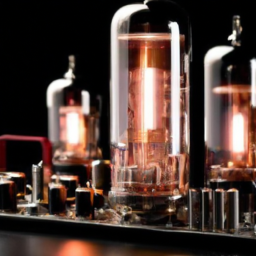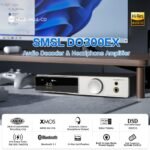Picture this: You’re sitting in your favorite corner of the house, a cozy armchair surrounded by shelves filled with your prized vinyl collection. The warm glow of the record player fills the room, and you can’t help but bask in the richness of the music. But have you ever wondered what makes that sound genuinely exceptional? One crucial element often unnoticed is the amplifier class in audiophile setups. In this article, we’ll explore the significance of the amplifier class and how it can elevate your listening experience to new heights. So sit back, relax, and prepare to uncover the secrets behind that captivating audio journey.
Understanding the Basics of Amplifier Classes
Defining Amplifier Classes
When understanding the different types of amplifiers available in the market, it is essential to start by defining what amplifier classes are. An amplifier class refers to the type of circuitry used in an audio amplifier to amplify the electrical signals from your source devices, such as CD players or turntables, to a level suitable for driving speakers.
The Importance of Amplifier Class in Audio Quality
The choice of amplifier class can significantly impact the audio quality in your audiophile setup. Different amplifier classes have varying characteristics that can affect sound quality, power efficiency, and overall performance. Understanding these differences is essential to make an informed decision when selecting an amplifier for your audio system.
Brief History of Amplifier Classes
Amplifier classes have evolved over the years, offering each type its advantages and disadvantages. While the earliest amplifiers were simple Class A designs, advancements in technology led to the development of other styles, such as Class B, Class AB, and Class D. Each type has its unique operating principles and designs, catering to different needs and preferences within the audiophile community.
Detailed Look at Class A Amplifiers
Operating Principles of Class A Amplifiers
Class A amplifiers are known for their simplicity and uncompromised audio quality. They keep the output devices constantly conducting current, regardless of the input signal level. This ensures that the amplifier is always “on” and ready to respond to any changes in the audio signal, resulting in a smooth and accurate reproduction of the original sound.
Strengths and Weaknesses of Class A
Class A amplifiers’ significant strengths are their ability to deliver excellent sound quality with low distortion levels. The constant current flow in Class A amplifiers eliminates any issues related to crossover distortion, resulting in a more accurate and detailed sound reproduction. However, this advantage comes at a cost – Class A amplifiers are highly inefficient and generate a significant amount of heat, making them less practical for high-power applications.
Ideal Uses for Class A Amps in Audiophile Setups
Given their excellent sound quality, Class A amplifiers are often favored in high-end audiophile setups where sonic accuracy and musicality are highly valued. Due to their lower power output, Class A amplifiers are commonly used in conjunction with efficient speakers, ensuring that the full potential of the amplifier is utilized while maintaining a balanced system.
Exploration of Class B Amplifiers
How Class B Amplifiers Work
Unlike Class A amplifiers, Class B amplifiers divide the audio signal into positive and negative halves, each amplified by a separate transistor or tube. While this design allows for greater efficiency, it introduces a crossover distortion where the output signal may exhibit a slight distortion at the point where the positive and negative halves of the signal meet.
Pros and Cons of Class B Amps
One of the significant advantages of Class B amplifiers is their efficiency. By only conducting current during half cycles of the audio signal, Class B amplifiers can achieve higher power efficiency compared to Class A. However, introducing crossover distortion can negatively impact sound quality, resulting in a slightly compromised audio reproduction.
Perceived Sound Quality of Class B in Audiophile Setups
In audiophile setups, Class B amplifiers are often perceived as a more budget-friendly option that can still deliver decent sound quality. While they may not provide the same audio accuracy and detail level as Class A amplifiers, Class B amplifiers can be a suitable choice for those seeking a balance between price and performance.
Insight into Class AB Amplifiers
Understanding the Hybrid Design of Class AB
Class AB amplifiers aim to balance the efficiency of Class B amplifiers and the sound quality of Class A amplifiers. They combine Class A and Class B operating principles, with one transistor or tube conducting current during lower signal levels (Class A region) and additional transistors or tubes being activated during higher signal levels (Class B region).
Advantages and Disadvantages of Class AB
One of the significant advantages of Class AB amplifiers is their improved power efficiency compared to pure Class A designs. By switching between Class A and Class B operations, Class AB amplifiers can deliver higher power output while minimizing the issues associated with crossover distortion. However, due to the additional circuitry involved, Class AB amplifiers can be more complex. They may introduce some level of distortion, although it is typically lower than Class B designs.
Class AB Amps in High-End Audiophile Systems
Class AB amplifiers are commonly used in high-end audiophile systems where the desire for both power efficiency and sound quality is paramount. Their ability to balance Class A and B characteristics allows for a broader range of speakers to be driven effectively while maintaining high audio fidelity.
Introduction to Class D (Switching) Amplifiers
Operating Mechanism of Class D Amplifiers
Class D amplifiers, also known as switching amplifiers, differ significantly from the previously discussed classes. Instead of continuous analog signals, Class D amplifiers convert the audio signal into a series of pulses that rapidly switch between two voltage levels. The resulting pulse-width modulated (PWM) signal is then filtered to reconstruct the original audio waveform.
Benefits and Drawbacks of Class D
One of the significant benefits of Class D amplifiers is their high power efficiency. Using switching techniques, Class D amplifiers can achieve up to 90% or higher efficiencies, resulting in reduced heat generation and longer amplifier lifespan. However, the modulation and filtering processes involved introduce some distortion and can potentially impact the overall sound quality, although technological advancements have significantly minimized these concerns.
Class D Amps in Compact and Energy-Efficient Audiophile Setups
Class D amplifiers have recently gained popularity, particularly in compact and energy-efficient audiophile setups. Their high power efficiency and smaller form factor make them an ideal choice for applications such as home theaters, portable audio systems, and car audio installations. While some audiophiles may still prefer the sound characteristics of traditional classes, Class D amplifiers offer a compelling alternative for those seeking a balance between performance and practicality.
Other Specialized Amplifier Classes
Overview of Class T, G, and H Amplifiers
In addition to the commonly discussed classes, other specialized amplifier classes cater to specific needs and requirements. Class T amplifiers, for example, employ digital amplification techniques and are known for their compact size and high efficiency. Class G and Class H amplifiers utilize multiple power supply voltages to improve efficiency, especially at lower power levels.
The Roles of Specialized Amplifier Classes in Audiophile Setups
Specialized amplifier classes can offer unique advantages depending on the specific requirements of an audiophile setup. Class T amplifiers, for instance, can provide high power efficiency and low heat generation, making them suitable for compact and energy-conscious arrangements. ON THE OTHER HAND, Class G and Class H amplifiers may offer improved efficiency without compromising overall sound quality, making them a viable option in specific high-end applications.
Considerations When Choosing Specialized Amp Classes
When considering specialized amplifier classes, assessing your needs and priorities is essential. Factors such as power requirements, available space, and intended use of your audio system will significantly determine the most suitable amplifier class for your setup. Consulting with audio experts or conducting thorough research is highly recommended to make an informed decision.
Comparing Amplifier Classes on Sound Quality
Effects of Amplifier Class on Sound Output
The amplifier class can directly impact the sound quality produced by an audio system. While all amplifier classes strive to accurately reproduce the original audio signal, differences in operating principles and circuit designs can introduce varying levels of distortion and coloration in the resulting sound. It is essential to understand these differences when comparing amplifier classes based on sound quality.
Class Comparisons Based on Sound Clarity and Distortion Levels
When comparing amplifier classes, evaluate their performance in terms of sound clarity and distortion levels. Class A amplifiers, for example, are often praised for their accurate and detailed sound reproduction with minimal distortion. On the other hand, Class D amplifiers may introduce some distortion levels due to the modulation and filtering processes involved. However, advancements in technology have significantly improved their performance in this regard.
Subjective Preferences among Audiophiles
It is worth noting that subjective preferences among audiophiles also play a significant role in determining the perceived sound quality of different amplifier classes. Some individuals may prefer the warmth and musicality of Class A amplifiers, while others may appreciate the efficiency and power of Class D amplifiers. Ultimately, personal listening tests and individual preferences should guide decision-making when considering amplifier classes based on sound quality.
The Role of Amplifier Class in Power Efficiency
Understanding Power Efficiency in Amplifiers
Power efficiency refers to the ability of an amplifier to convert the electrical power from the power source into helpful output power. It is an important consideration, particularly in terms of energy consumption and heat generation. Amplifier classes can vary significantly regarding power efficiency, with some types offering higher efficiency levels than others.
Comparison of Amp Classes in Terms of Power Consumption
Class A amplifiers are known to be the least efficient in terms of power consumption. Due to their constant current flow, Class A amplifiers consume significant power even when no audio signal is present. On the other hand, Class D amplifiers can achieve much higher efficiencies by utilizing switching techniques and operating only when required. Class AB amplifiers offer a balance between these extremes.
Implications for Audiophile Setups and Long-Term Use
The power efficiency of amplifier classes has practical implications for audiophile setups, particularly in energy consumption and heat management. Higher power efficiency not only reduces your electricity bills but also helps minimize heat generation, potentially increasing the lifespan of your amplifier. It is essential to consider the power efficiency of different classes when making your amplifier selection, ensuring it aligns with your long-term needs and concerns.
Considerations When Choosing Amplifier Class for Your Setup
Balancing Sound Quality and Power Efficiency
One of the critical considerations when choosing an amplifier class for your setup is finding the right balance between sound quality and power efficiency. While Class A amplifiers may offer unparalleled quality, their lower power efficiency may not be suitable for all applications. On the other hand, Class D amplifiers provide high power efficiency but may introduce some distortion. Understanding your priorities and finding a reasonable trade-off is crucial in making an informed decision.
Considering Room Size and Speaker System
Another essential factor to consider is the size of your listening room and the characteristics of your speaker system. Different amplifier classes have varying power requirements and output capabilities, which may or may not be suitable for your particular setup. Matching the amplifier class to your room and the speakers’ specific needs and restrictions is essential to ensure optimal performance.
Cost and Care Considerations
Cost and maintenance considerations should also be considered when choosing an amplifier class. Class A amplifiers, for example, tend to be more expensive due to their high-quality components and construction. Their constant current flow may require careful thermal management to avoid overheating. Class D amplifiers, on the other hand, offer cost-effective solutions with less heat generation. Considering your budget and the care required for different amplifier classes will help you make a practical decision.
Future Trends in Amplifier Class Technology
Emerging Amplifier Classes and Technologies
As technology advances, new amplifier classes and technologies are constantly being developed. Examples include Class E, T, and digital amplification techniques. Class E amplifiers, for instance, are known for their high efficiency and are commonly used in wireless communication systems. Based on integrated circuits, Class T amplifiers offer compact size and energy-efficient operation. Digital amplification techniques, such as pulse density modulation (PDM), are also gaining attention for their potential to improve the performance of Class D amplifiers further.
Speculations on Impact on Audiophile Setups
The emergence of new amplifier classes and technologies holds promising potential for the future of audiophile setups. Advancements in efficiency, power output, and sound quality may reshape the landscape of amplifier selection, offering audiophiles even more choices and possibilities. As these technologies mature and become more accessible, seeing how they integrate into existing and future audiophile systems will be interesting.
Implications for the Evolution of Audiophile Sound Quality
Ultimately, the evolution of amplifier-class technology will have significant implications for the overall sound quality in audiophile setups. Audiophiles can expect improvements in efficiency, power output, and distortion levels as new classes and technologies emerge. With the possibility of achieving higher fidelity and precision in audio reproduction, the future of amplifier-class technology holds great promise for enhancing the audiophile experience.










